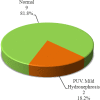Incidence of urinary tract infection in neonates with significant indirect Hyperbilirubinemia of unknown etiology: case-control study
- PMID: 33596989
- PMCID: PMC7891145
- DOI: 10.1186/s13052-021-00982-0
Incidence of urinary tract infection in neonates with significant indirect Hyperbilirubinemia of unknown etiology: case-control study
Abstract
Background: Indirect hyperbilirubinemia is frequently encountered during neonatal period. Although it has different causes, in some cases it can't be explained. Previous studies have illustrated that jaundice could be a major sign of urinary tract infection (UTI) in neonates.
Aim of the work: We aimed to determine the association between UTI and significant unexplained neonatal indirect hyperbilirubinemia.
Methods: This prospective controlled study was performed on 150 neonates divided in two groups (100 as cases and 50 as controls) to investigate the incidence of UTI in neonates with significant unexplained hyperbilirubinemia. Urine sample was obtained using urine catheterization technique from neonates and full urine analysis was done and cases with pyuria had urine culture to confirm UTI. Immediate renal ultrasonography (USG) was performed for neonates with UTI.
Results: UTI incidence was 11% in cases while none of neonates in control group had UTI with statistical significance between cases and controls (P value < 0.05). The most common (36.4%) pathogen was Escherichia coli. Posterior urethral valve with mild hydronephrosis was diagnosed in 18.2% of UTI positive patients by renal ultrasonography.
Conclusion: In neonates with unexplained indirect hyperbilirubinemia, UTI should be considered as a pathological cause.
Keywords: Hyperbilirubinemia; Incidence; Neonates; Urinary tract infection.
Conflict of interest statement
The authors declare that they have no competing interests.
Figures


Similar articles
-
Unexplained neonatal jaundice as an early diagnostic sign of urinary tract infection.Int J Infect Dis. 2012 Jul;16(7):e487-90. doi: 10.1016/j.ijid.2012.02.011. Epub 2012 Apr 16. Int J Infect Dis. 2012. PMID: 22512850
-
Urinary Tract Infection in Asymptomatic Newborns with Prolonged Unconjugated Hyperbilirubunemia: A Hospital based Observational study from Western Region of Nepal.Kathmandu Univ Med J (KUMJ). 2016 Jan-Mar;14(53):41-46. Kathmandu Univ Med J (KUMJ). 2016. PMID: 27892440
-
Evaluation of urinary tract infections in neonatal indirect hyperbilirubinemia.Minerva Pediatr (Torino). 2022 Oct;74(5):562-567. doi: 10.23736/S2724-5276.21.06295-9. Minerva Pediatr (Torino). 2022. PMID: 36346379
-
Factors Affecting Prevalence of Urinary Tract Infection in Neonates with Unexplained Hyperbilirubinemia: A Systematic Review and Meta-Analysis Study in Iran.Iran J Public Health. 2021 Jul;50(7):1311-1323. doi: 10.18502/ijph.v50i7.6617. Iran J Public Health. 2021. PMID: 34568169 Free PMC article. Review.
-
Diagnosis and management of urinary tract infection and vesicoureteral reflux in the neonate.Clin Perinatol. 2014 Sep;41(3):633-42. doi: 10.1016/j.clp.2014.05.011. Epub 2014 Jul 18. Clin Perinatol. 2014. PMID: 25155732 Review.
Cited by
-
Prenatal Diagnosis of Ductal Constriction in Normal Heart Anatomy-Are There Any Neonatal Consequences?J Clin Med. 2025 May 13;14(10):3388. doi: 10.3390/jcm14103388. J Clin Med. 2025. PMID: 40429383 Free PMC article.
-
Epidemiological insights into seasonal, sex‑specific and age‑related distribution of bacterial pathogens in urinary tract infections.Exp Ther Med. 2024 Feb 14;27(4):140. doi: 10.3892/etm.2024.12428. eCollection 2024 Apr. Exp Ther Med. 2024. PMID: 38476915 Free PMC article.
-
Risk factors for urinary tract infection in infants with unexplained hyperbilirubinemia: a single center case-control study.Front Pediatr. 2024 Jan 25;12:1332052. doi: 10.3389/fped.2024.1332052. eCollection 2024. Front Pediatr. 2024. PMID: 38333085 Free PMC article.
References
-
- Pashapour N, Nikibahksh AA, Golmohammadlou S. Urinary tract infection in term neonates with prolonged jaundice. Urol J. 2007;4:91–94. - PubMed
-
- Bilgen H, Ozek E, Unver T, Biyikli N, Alpay H, Cebeci D. Urinary tract infection and hyperbilirubinemia. Turk J Pediatr. 2006;48:51–55. - PubMed
-
- Zafarzadeh M, Mohammadzadeh A. Should urine culture be considered in the hyperbilirubinemia work up of neonate? J Chinese Clin Med. 2009;4(3):136–138.
Publication types
MeSH terms
LinkOut - more resources
Full Text Sources
Other Literature Sources
Medical
Research Materials

